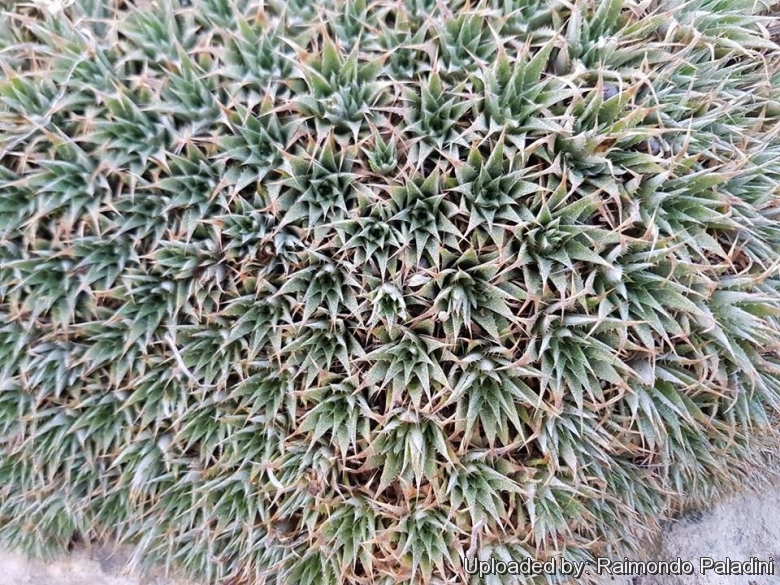Accepted Scientific Name: Deuterocohnia brevifolia (Griseb.) M.A.Spencer & L.B.Sm.
Bradea 6(16): 144 (1992)

Lindmania brevifolia (Deuterocohnia brevifolia) Photo by: Raimondo Paladini
Origin and Habitat: Deuterocohnia brevifoliaSN|14678]]SN|14678]] is native to Argentina (Catamarea, Sierra de Anconguija; Tucuman, Quebrada de la Hoyada; Jujuy, El Volcani; Salta, Pampa Granda) and Bolivia: Valle de Tambo.
Habitat: Deuterocohnia brevifoliaSN|14678]]SN|14678]] is a dense, cushion-like plant, clambering over the rocks on steep walls in a very arid area. As the plant grows and branches the mounding colony spreads outward covering rock and sloping hillsides helping to slow run-off and prevent soil erosion. In its environments it is watered perhaps only twice a year, finding all of its moisture from the air itself. The only water it ever gets is in the form of sea fog. It is a very variable species from quite variable habitats. In humid, seasonally
Synonyms:
See all synonyms of Deuterocohnia brevifolia
back
Accepted name in llifle Database:Deuterocohnia brevifolia (Griseb.) M.A.Spencer & L.B.Sm.Bradea 6(16): 144 (1992)Synonymy: 13
back
Description: Deuterocohnia brevifoliaSN|14678]]SN|14678]] (Abromeitiella brevifoliaSN|14680]]SN|14680]]) is a dwarf, succulent, bromeliad growing terrestrially. It forms 3-5 cm wide rosettes of lance-shaped to triangular stiff, fleshy, leaves that proliferate via offsets to form a compact rounded 'mound' up to 90-180 cm in diameter. These colonies from a distance often look soft and moss-like but they are anything but soft and cushy and touching or sitting on a plant would but more like encountering a bed of nails. Inconspicuous green flowers are borne on short inflorescences. A. brevifolia, distinguished by its relatively smooth leaf margins, has both a large and a small form, the latter (often with many marginal teeth) sometimes sold under the synonym A. chlorantha.
Rosettes: Small, star-like, compact of elongated triangular leaves about 3 cm long, thick and fleshy with spineless margins. It is a very variable species from quite variable habitats. In humid, seasonally wet areas the little rosettes can be green, glabrous and glossy but in more arid locations the plants leaf surfaces can posses varying amounts of trichomes giving the rosettes a greenish-gray appearance.
Leaves: Simple, basal, and sessile. Ovate-triangular, 2-3 cm long, at the base 8-14 mm wide, tapering, margins spineless or spiny (subsp. chlorantha), fleshy-thick.
Flowers: 'cannon-shaped' about 32-33 mm long, 6-7 mm wide, greenish to bright green.
Taxonomy: Deuterocohnia brevifoliaSN|14678]]SN|14678]] was already described and the name validly published by August Heinrich Rudolf Grisebach. It was Michael A. Spencer and Lyman Bradford Smith, however, who reclassified it into todays valid botanical systematics in 1992.
Subspecies, varieties, forms and cultivars of plants belonging to the Deuterocohnia brevifolia group
 Deuterocohnia brevifolia (Griseb.) M.A.Spencer & L.B.Sm.: Leaves with few marginal teeth. Distribution: Argentina (Catamarea, Tucuman, Jujuy& Salta) and Bolivia (Valle de Tambo).
Deuterocohnia brevifolia (Griseb.) M.A.Spencer & L.B.Sm.: Leaves with few marginal teeth. Distribution: Argentina (Catamarea, Tucuman, Jujuy& Salta) and Bolivia (Valle de Tambo).  Deuterocohnia brevifolia subs. chlorantha (Speg.) W.Schultze-Motel: is a smaller form with leaves with many marginal teeth. Distribution: Argentina in the region of Tucuman and southern Bolivia.
Deuterocohnia brevifolia subs. chlorantha (Speg.) W.Schultze-Motel: is a smaller form with leaves with many marginal teeth. Distribution: Argentina in the region of Tucuman and southern Bolivia.
Bibliography: Major references and further lectures
1) Hermann Jacobsen, "Abromeitiella to Euphorbia", Blandford Press, 1960
2) Clive Innes "Complete Handbook of Cacti and Succulents", Van Nostrand Reinhold Company, 01/Dec/1981
3) Smith, L.B. & Downs, R. J. Abrometiella in: "Flora Neotropica" 14:241-244 1974
4) "Dry Climate Gardening with Succulents", Pantheon Books, 1995
5) Ulrich Baensch, Ursula Baensch, "Blooming bromeliads", Tropic Beauty Publishers, 1994
6) Yucca Do Nursery, inc. "Deuterocohnia brevifolia f. Chlorantha" web: <https://www.yuccado.com/deuterocohnia-brevifolia-f-chlorantha.html>
7) Gerald Klingaman, "Plant of the Week: Deuterocohnia brevifolia Bromeliad-02-20-15" web: <https://uaex.edu/yard-garden/resource-library/plant-week/Deuterocohnia%20brevifolia.aspx>
Cultivation and Propagation: Deuterocohnia brevifoliaSN|14678]]SN|14678]] (Abromeitiella brevifoliaSN|14680]]SN|14680]]) is a peculiar little plant occurring in dense, pillow-like clusters, suited to plant between stones or even into flat bowls into clayey ground in the greenhouse for succulent plants. Grow it like succulents in in full sun to light shade and well drained soil. They are slow growing and very drought tolerant. They should be watered regularly especially during summer months, keep dry in winter. It is probably one of the cold hardiest of the bromeliads, but detesting winter wet on its foliage, proves difficult to keep outside. When grown in pots it tends to spread out uniformly in all directions and given enough time makes a mound of foliage in the shape of a basketball cut in half that completely obscures the pot. ?
Propagation: Deuterocohnia brevifoliaSN|14678]]SN|14678]] is propagated by division and from seed when available. Among the smaller species, it is a natural addition to a succulent collection.









